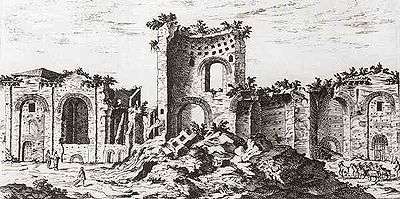Étienne Dupérac
Étienne Dupérac (or du Pérac) (c. 1525–March 1604) was a French architect, painter, engraver, and garden designer.[1] He is most well known for his topographical studies of Rome and its ruins in the late 16th century.[2]

Rome
Dupérac was born in Bordeaux[2] or Paris[3] and arrived in Rome in 1550, where he became a skilled designer and engraver.[2] He published a bird's-eye view of Ancient Rome with buildings reconstructed (Urbis Romae Sciographia, 1574) and one of modern Rome (Descriptio, 1577)[4] and a book of forty engravings of Roman monuments and antiquities, I vestigi dell'antichità di Roma (Rome, 1575).[2]
An unpublished book of drawings on parchment of ruins of Rome confronted with reconstructions of their original appearance, from the same angle, Disegni de le Ruine di Roma e Come Anticamente Erono, attributed to him and dated c. 1564-1574 was published in facsimile (Milan 1964) with an introduction by Rudolf Wittkower, who dated them on the basis of the actual state of the buildings shown;[5] the text that must have accompanied the drawings has not survived, and Dupérac's authorship has been called into question.[6] The book is part of the collection of the Morgan Library & Museum in New York (acc. no. MS M.1106).

Dupérac's engravings of modern Rome, such as the carrousel in the Cortile del Belvedere or his bird's-eye view of the Villa d'Este,[2] served to transmit architectural and gardening ideas to France and the north of Europe. Dupérac worked for a time for Antonio Lafreri.[7]
France
On his return to France by 1578,[8] Dupérac was commissioned to paint the Cabinet des Bains at the Château de Fontainebleau, and may have designed some of the gardens.[9] He has also been credited with the design of the gardens at Anet, as architect to the duke of Aumale. As architect to Henri IV beginning in 1595, he may have designed the terraced gardens at Saint-Germain-en-Laye, and was engaged in work at the Tuileries in Paris (c. 1600–1603).[3]
Dupérac died in Paris.[1]
An album signed by Dupérac and dated 1575, Illustration des fragments antiques, is conserved in the Musée du Louvre. An etching from Speculum Romanae Magnificentiae is exhibited in the Palazzo Braschi in Rome.[10]
Notes
- "Dupérac, Etienne", Union List of Artist Names Online.
- Arnold 1998.
- Miller 1982.
- It is a uniquely detailed representation of Rome as it was before the urbanistic projects of Sixtus V; it was published, as Roma primo di Sisto V, with an introduction by Francesco Ehrle (Rome: Danesi) 1908.
- The codex was discovered by T. Ashby in the Dyson Perrins collection and thoroughly described in Archaeological Journal, 1908, then issued with an extended version of Ashby's article as preface, in an expensive facsimile, (London:Roxburghe Club, 1916).
- Zerner 1965.
- Known as the entrepreneur behind the Lafreri atlases.
- He was documented at Caen in 1578, and in Paris, October 1580 (Zerner 1965, pp. 507 note 2 and 508). Zerner doubted Ashby's and Wittkower's attribution of the mutilated Ashby Codex (Morgan Library & Museum acc. no. MS M.1106) to Dupérac.
- Claude Mollet, in his Théâtre des plans et iardinages (posthumous, 1652), claimed to have been the first to introduce parterres de broderie in France, from having been inspired by Dupérac (noted by Karling 1974, p. 8).
- Etching of Seven Pilgrimage Churches of Rome
Sources
- Arnold, Dana (1998). "Dupérac, Etienne" in Turner 1998, vol. 9, p. 398.
- Karling, Sten (1974). "The importance of André Mollet and his family for the development of the French formal garden", pp. 2–25, in The French Formal Garden, edited by Elizabeth B. Macdougall and F. Hamilton Hazlehurst. Washington: Dumbarton Oaks. ISBN 9780884020523.
- Miller, Naomi (1982). "Dupérac, Etienne", vol. 1, p. 613, in Macmillan Encyclopedia of Architects, edited by Adolf K. Placzek. New York: The Free Press. ISBN 9780029250006.
- Turner, Jane, editor (1998). The Dictionary of Art, reprinted with minor corrections, 34 volumes. New York: Grove. ISBN 9781884446009.
- Zerner, Henri (1965). "Observations on Dupérac and the Disegni de le ruine di Roma e come anticamente erono", The Art Bulletin, vol. 47, no. 4 (December 1965), pp. 507–512.
External links
